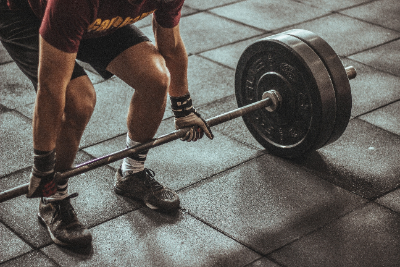What do you think of when you hear the term ‘Strength & Conditioning’? As a runner, cyclist, triathlete, or endurance athlete, is it something you can relate to?
A great deal of Strength and Conditioning (S&C) information and research comes from Powerlifting, Olympic lifting and team sport environments.
In terms of the research, funding, equipment and practical application, much of this has been targeted at the development of non-endurance based, dynamic, strength-based sports, such as rugby and football.
Endurance athletes could be forgiven for dismissing strength training as irrelevant to their training requirements, especially when social media channels promote the extreme benefits of S&C, such as stage-ready bodybuilding physiques.
However, there's been a steady stream of literature over the last couple of decades that's supported the use of strength and conditioning training principles for the endurance population.
So, let’s look at what the research says about strength training and how we as endurance athletes can use the science to elevate our own performance...
The benefits of S&C
Integrating an individualised S&C program into an athlete's training program is going to provide the foundation for a successful athletic career. If we look at any sport that's played professionally, there's a S&C component to the majority of training programs, as this generally provides the platform (specifically the environment and education) to work on areas of the athletes' physiology that aren't targeted enough within their specific sport's training.
However, there's a mistaken belief in the world of endurance sports that lifting heavy weights is too excessive and that bodyweight training is sufficient. Essentially, these athletes are missing out on the primary benefits of progressive overload and maximal strength for performance.
More Strength = More Power, Speed and Endurance
A common phrase used amongst those in the strength training world is that "strength is the prerequisite to power and speed', and that it will always be difficult to produce large peak power outputs without first having high levels of strength.
Stone et al (2016) argued that the average power is a deciding factor in winning or losing for endurance activities. Therefore, the ability to generate force (strength), which is an integral part of power production, may be a key component in determining athletic success. Aagaard and Andersen (2010) discovered that an increase in strong, lean muscle tissue allows muscle fibres to be more resistant to fatigue, meaning that they can produce a higher maximal force and can elevate the rate of force development in muscles.

Whether you're a coach working with endurance athletes or you're training for endurance yourself, it would be fair to assume from the literature (and also from basic logic) that increasing your baseline level of strength and increasing your natural strength-to-weight ratio will allow you to essentially train and tap into more muscle tissue. It's a concept supported by Sedano et al., who found that athletes with stronger and more powerful muscles were able to increase their peak movement speed.
Essentially working on your maximal strength is going to allow you to tap into greater levels of speed and endurance. Who’s going to say no to more speed or endurance?!
Movement Economy: Same task, less effort
As an endurance athlete who's looking to navigate high volumes of training load, whether it be run, bike, swim, hike, ski or climb, there are two variables that you're essentially always looking to improve upon - Movement Economy and Movement Efficiency.
By identifying ways to upgrade the way you manage your body mass across distances and terrains with movement efficiency and economy (meaning you perform the same efforts with less energy usage or wastage), you're likely to be more successful over the long term.
Paavolainen et al (1999) found that simultaneous explosive-strength training and endurance training improved the 5km run time in well-trained endurance athletes without changes in their VO2 max, due to the improved VMART (maximal velocity in anaerobic/aerobic treadmill running test) and running economy.
Movement economy benefits have also been found in cycling. Rønnestad et al (2011) concluded that the addition of strength training alongside usual endurance training improves leg strength and 5-minute all-out performance following 185 minutes of cycling in well-trained cyclists.

Furthermore, research by Beattie et al (2014) found that there's an improvement of motor unit recruitment and muscular coordination due to strength training. Another way to explain this is that the correct muscles can be activated faster, more powerfully and more efficiently, and are able to work more harmoniously within the kinetic chain of the movement.
As a result, by improving your movement efficiency through strength training, you're naturally going to reduce the likelihood of injuries, because you're able to hold more efficient positions for longer; in the water, on the bike or on the run.
Interestingly, Noakes (1991) speculated that runners with poor running economy might have muscles that are less able to utilise the impact energy produced as they eccentrically absorb the force of landing. It's been further suggested that the relative stiffness of the musculo-tendinous system (MTS) may determine the body’s ability to store and utilise such energy (Wilson et al., 1991). What does this mean? There's great value in understanding and continuing to develop your ability to produce and absorb force, and strength training provides a safe and controlled environment to do so.
Although anaerobic factors are considered less vital in endurance sports, strength training improves Glycolysis, PCr stores & utilisation and the buffering capacity of lactic acid. In a joint-study conducted in 2014 by Beattie, Kenny, Luons and Carson, these factors were confirmed to all contribute to an improved lactate threshold, which is a key performance marker in endurance athletes.
So, by working at higher intensities within your S&C training, you're going to be creating anaerobic-based training effects which will always have a positive impact on your overall aerobic abilities too.
How often should you be doing S&C?
With all of this supporting evidence, it's clear that we need to be applying S&C principles into our weekly training, but how do we integrate this into our lifestyle?
Essentially, we're looking to include 2-3 S&C sessions a week that stand alone from your sport sessions, as this level of frequency is considered to produce significant results from a program (Ralston et al., 2018).
However, what we must remember is that when it comes to any successful program, it’s always going to come down to the level of experience and understanding of the individual. Even with all of the research and literature that's covered the optimal frequency, type, and volume, there are so many variables when training for an endurance sport that you simply can’t apply “rules” without logic or real-world consideration.
You'll want to have an individualised program that's targeting your key areas of weakness or development, and is also progressive in nature, so that there's adjustments to the intensity and complexity of exercises occurring on a week-to-week basis.
For you to experience any of the above benefits of a complete S&C program, a certain level of accountability and feedback will be essential for continued development. So, finding yourself an experienced training environment, community or coach will set you on the right path.
